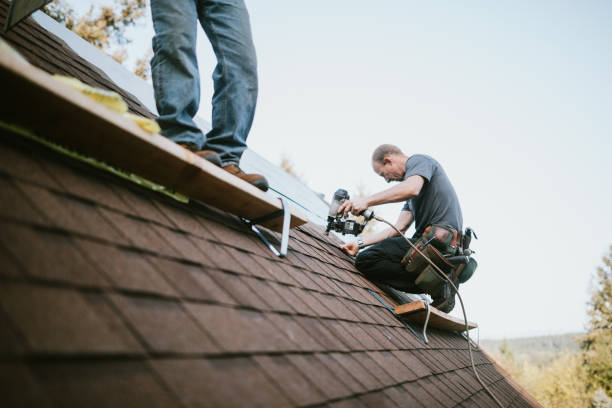Your roof is more than just the capstone of your home—it’s a vital shield that protects your family and possessions from the elements. Ensuring your roof is well-maintained with the help of professionals like Chad Dodson Roofing can significantly extend its life and save you money in the long run.
Understanding Your Roof’s Needs
Every roof has its unique requirements based on the materials used, the climate in your area, and the age of the structure. By understanding these needs, you can better anticipate and address issues before they become major problems.
Common Roof Types and Their Lifespans
- Asphalt Shingles – Typically last 20-30 years. Regular maintenance can help reach the upper end of this range.
- Metal Roofing – Known for durability, can last 40-70 years with minimal maintenance.
- Clay Tiles – Can endure for up to 100 years with proper care.
- Wood Shingles – Generally last 25-30 years but require regular treatment to prevent rot and insect damage.
- Slate Roofing – Extremely durable, often lasting over 100 years.
Signs Your Roof Needs Attention
Recognizing early signs of wear and tear can help you intervene before minor issues escalate into costly repairs.
- Missing or Damaged Shingles – Look for cracks, curling, or missing pieces.
- Leaks and Water Stains – Check your attic and ceilings for water spots.
- Sagging Roof Deck – Indicates structural issues that need immediate attention.
- Granule Loss – Noticeable when asphalt shingles shed granules, seen in gutters and downspouts.
- Moss or Algae Growth – While often a cosmetic issue, it can indicate trapped moisture.
Routine Maintenance Tips
Regular maintenance is the cornerstone of extending your roof’s life. Implementing a consistent schedule can help you spot and fix problems early.
Seasonal Inspections
Conduct roof inspections at least twice a year, ideally in the spring and fall. Look for debris accumulation, gutter health, and sealant checks. Remove leaves, branches, and other debris that can trap moisture. Ensure gutters are clean and free-flowing to prevent water damage. Inspect and reapply sealants around chimneys, skylights, and vents as needed.
Addressing Small Repairs Immediately
Small issues can rapidly escalate if left unchecked. Secure or replace any loose or damaged shingles. Ensure the metal flashing around vents and chimneys is secure and watertight. Use a mixture of water and bleach to clean moss and algae growth and prevent future accumulation.
Professional Inspections and Repairs
While DIY maintenance is crucial, professional inspections and repairs ensure your roof remains in optimal condition.
When to Call a Professional
Certain signs indicate the need for professional expertise. If you spot a significant leak, a professional can assess the extent of the damage and repair it. Large areas of damaged shingles may require professional replacement. Sagging or structural damage needs immediate professional attention.
Benefits of Professional Maintenance
Hiring a professional offers several advantages. Professionals can identify and fix problems that may not be apparent to an untrained eye. Roofing can be dangerous; professionals have the necessary safety equipment and training. They can also provide long-term solutions rather than temporary fixes.
Proactive Measures for Longevity
In addition to regular maintenance and repairs, proactive measures can significantly extend your roof’s life.
Installing Roof Ventilation
Proper ventilation is crucial to prevent heat and moisture buildup, which can damage your roof and shorten its lifespan. Installing ridge vents, soffit vents, and gable vents ensures proper airflow. Consider installing attic fans or exhausts to enhance ventilation, especially in humid climates.
Using Quality Materials
Investing in high-quality materials can pay off in the long run. Opt for shingles with higher durability and better weather resistance. Use top-tier sealants to protect vulnerable areas like flashing and vents. A quality underlayment provides an additional layer of protection against leaks.
Weatherproofing
Protect your roof from extreme weather conditions by taking the necessary steps. Installing storm straps can secure your roof in areas prone to high winds or hurricanes. In colder climates, using an ice and water shield can prevent damage from ice dams and heavy snow.
Addressing Specific Climatic Challenges
Your roof faces unique challenges depending on your local climate. Tailoring your maintenance and repair strategies to these conditions can further extend its life.
Hot and Dry Climates
In areas with intense heat and low humidity, use UV-resistant materials to prevent damage from prolonged sun exposure. Regularly inspect for cracks and brittleness, common issues in extreme heat.
Cold and Snowy Climates
For regions with harsh winters, regularly remove snow to prevent excessive weight and ice dams. Ensure your attic is well-insulated and ventilated to prevent ice formation.
Humid and Rainy Climates
In areas with high humidity and frequent rain, regularly clean your roof to prevent moss and algae growth. Use waterproof materials and ensure gutters and downspouts are functioning correctly.
DIY vs. Professional Repairs
Deciding whether to handle roof repairs yourself or hire a professional can be challenging. For minor issues, DIY can be cost-effective and straightforward. Replacing a few shingles, clearing debris, and basic sealant work are manageable with the right tools. However, complex issues require professional intervention. Extensive damage, structural problems, and safety concerns should be addressed by a professional to ensure long-term stability and safety.
Investing in Your Roof’s Future
By investing time and resources into proper maintenance and timely repairs, you can significantly extend the life of your roof. This not only protects your home but also enhances its value and longevity. Remember, the key to a long-lasting roof lies in regular care, early detection of issues, and a balance between DIY efforts and professional help.
Final Thoughts
Regular inspections, prompt repairs, and proactive measures tailored to your specific climate are essential strategies for maximizing your roof’s lifespan.


